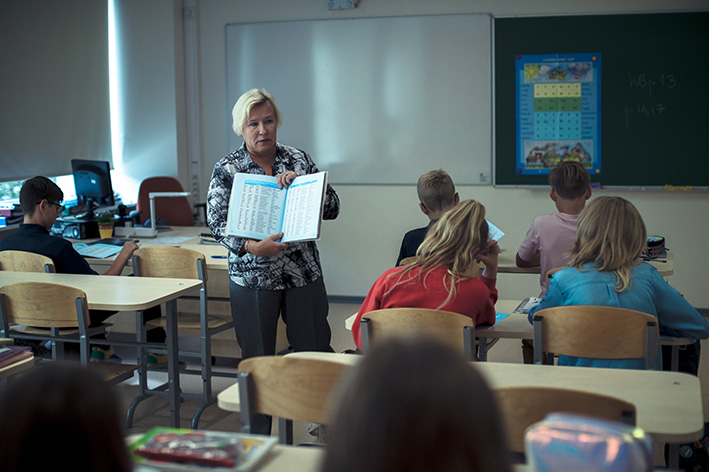Go-Far 2018: Eye on Estonia
Young Teachers: Absent
The profession has a bad rap because of low pay, long hours and hard work
By Gracia Lee
When Ms Kaire Papp decided to become a teacher at 24, her father, who was a teacher himself, was sceptical of her decision.
“He knew how difficult it would be,” said Ms Papp, now 27, who teaches English, art and science at Tallinn Art Gymnasium. The school caters to the Estonian equivalent of primary and secondary school students.
Ms Papp’s day begins at 8am when she arrives at school. The moment she steps in, it is a flurry of activity — darting in and out of classrooms, preparing teaching materials, delivering lessons and ensuring the younger ones stay out of trouble.
When the students have packed up and gone home at 3pm, she stays behind to attend meetings and work on school projects. She also finishes up the administrative work, assesses her students’ performance and prepares for the next day’s lessons. Her work day ends only at about 8pm.
For all her hard work, she is paid 1,150 euros (S$1,848) a month.
As a teacher under 30, Ms Papp makes up the smallest demographic of teachers in Estonia.
According to 2017 statistics by the Organisation for Economic Co-operation and Development (OECD), only nine per cent of the country’s 12,372 general education teachers are below 30. Estonia has the second oldest teaching workforce among OECD countries, with close to half of its teachers over 50.
The teaching industry is also dominated by females, who make up 83 per cent of the workforce.
Estonia is struggling to attract teachers due to low salaries and heavy workloads in the profession, said teachers and education experts.
Teachers earn significantly less than their counterparts in other countries. According to OECD statistics published last year, a teacher in Estonia earns an average of €22,066 (S$34,557) a year, half the OECD average of €44,275.
Teaching has traditionally been a low-paying field in Estonia, and the country has faced a shortage of teachers since the 2000s, especially after the emergence of well-paid jobs in the private sector.
In response, the government has been increasing teachers’ salaries over the past few years. The average teaching salary has increased by more than 40 per cent since 2011, and it is one of the fastest growing salaries in the country. However, it still remains slightly lower than the national average.
According to government agency Statistics Estonia, the average gross monthly salary of teachers in the first quarter of 2018 was €1,131 (S$1,772), lower than the national average of €1,242. It ranked below construction (€1,146), wholesale and retail trade (€1,150) and agriculture, fishing and forestry (€1,133).
Career progression is also limited. There are only three rungs — beginner, senior and master teachers — and teachers say that climbing the ladder does not bring in a much higher pay.
As a result, most teachers choose to take on more jobs for extra income. Some juggle work as translators, baristas, textbook writers, private teachers and even taxi drivers during the school year. Others use the summer break to do short-term jobs.

Ms Lonks teaches irregular verbs to her fifth grade class.
Photo by: Elina KostabiI
Ms Anneli Lonks, 53, who has been a teacher for 25 years, works as a city guide in the summer.
“I’m divorced and have two girls to raise on my own. The summer vacation was long and I was short on money, so this was the main reason I started working,” she said. In the past, she has also conducted private classes and taken on jobs during term time such as housekeeping and dog-walking.
Ms Margit Timakov, chairperson of the Estonian Association of Teachers, feels that a teacher’s heavy workload is also a deterrent to young people.
Teachers are responsible for a wide variety of tasks, including class preparation, student development discussions, meetings, administrative work and form class responsibilities.
According to Statistics Estonia, employees in Estonia work an average of 40.5 hours a week. But Ms Timakov estimates that teachers can spend up to 58 hours a week on work.
Estonian parents are also increasingly interested in what goes on at their children’s schools and some have become more demanding.
“With e-School, some parents regularly monitor how their children are doing, whether they were present at school, what grade they got and so on,” said Ms Timakov, adding that some parents approach teachers when their children receive poor grades.
E-School is a digital platform that allows parents to access to their child’s attendance information, homework, grades and student behaviour evaluations online. It is used in 85 per cent of schools.
“People say we get three (paid) months off in the summer, but when you add up the extra time we put in during the school year, it’s equalised very quickly,” said Ms Timakov.
Ms Merike Saar, 53, who has been in the profession for almost 30 years, also feels that teachers are not as highly regarded as they used to be.
According to the 2013 Teaching and Learning International Survey (TALIS), 86 per cent of teachers surveyed in Estonia felt that teaching is not a valued profession in society.
“Teachers used to be called the salt of the country. They were the focal people in local communities and big decision makers. But now they are just (seen as) small little parts of a system,” said Ms Saar.
TEACHER SHORTAGE
While the number of new teachers has increased by about 20 per cent every year since 2014, it is still not enough to replace an ageing workforce.
In the 2016/17 academic year, 11 per cent of teachers reached the retirement age of 63 while new teachers accounted for 5.8 per cent of the workforce, according to statistics by the Ministry of Education and Research.
As a result, many schools struggle with a shortage of teachers, particularly in the subjects of science, mathematics and the Estonian language. Some teachers are approached to take on extra classes to fill the shortage, while others split their time teaching at two schools.
Ms Mariliis Samberk, 31, a chemistry and biology teacher, sees the high demand for science teachers as an opportunity to earn more income. She shuttles between two schools and spends about 45 hours a week in school, excluding the time she spends on the work she brings home.
“It’s nice to interact with different environments and people, but it is also difficult because I’m a class teacher at one of the schools and sometimes I can’t be there when I have to be,” she added, referring to the equivalent of a form teacher in Singapore.

Ms Lonks explains the history of Tallinn’s clock tower to tourists from Belgium.
Photo by: Christy Yip
THE WAY FORWARD
The Estonian government has committed to raising teachers’ salaries and aims to make them at least equal to the average salary of higher education graduates, which is 120 per cent of the national average wage, by 2020.
The ministry has also been trying to improve the image of the teaching profession, said Mr Mart Laidmets, deputy secretary general at the Ministry of Education and Research.
Every International Teacher’s Day on Oct 5, teaching awards and government scholarships are handed out to educators at a gala broadcast on national television. The first televised gala was in 2013.
“If sports, cultural activities and business enterprises have these (awards and scholarships), then we should have it in education also,” said Mr Laidmets. “We want to help society and the teachers themselves to understand that teaching is important.”
With the help of universities, the ministry has also been providing training programmes on new teaching models, and is working on strengthening the support system for teachers.
The ministry also funds about a third of Noored Kooli, a programme aimed at attracting people with other professional backgrounds to the teaching profession.
The conventional path to becoming a teacher involves a three-year Bachelor’s degree course in any field and a two-year Master’s degree course in teaching.
But participants of Noored Kooli, who do not have teaching backgrounds, undergo a six-week accelerated training programme before being sent out to teach in schools for two years. During the school year, they attend trainings every fortnight and are also coached individually by a mentor.
Participant Karel Alliku, 33, who has a Master’s degree in fish farming, said he was attracted to the programme as it allowed him to work as a teacher while learning the ropes of education. Taking two years off work to do the full-time teaching course in university would have been financially infeasible, he said.
The programme is free for teachers in-training like him, and they are paid the normal teacher’s salary by the school they teach in.
Distance-learning programmes have also been introduced by the Institute of Education at the University of Tartu to provide teachers with more flexible employment opportunities.
Mr Eda Tagamets, a communications specialist at the school, said that the programmes involve mostly independent study. This allows them to work part-time or full-time as they pursue their Master’s studies, he added.
The government hopes that at least 12.5 per cent of the workforce will be under 30 by 2020.